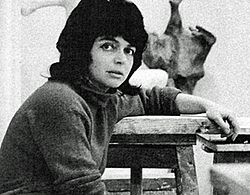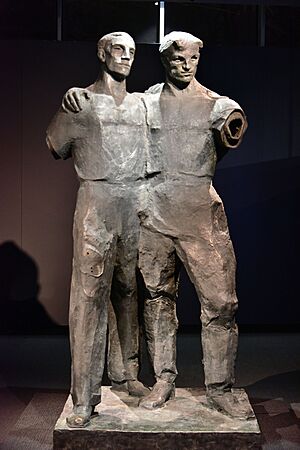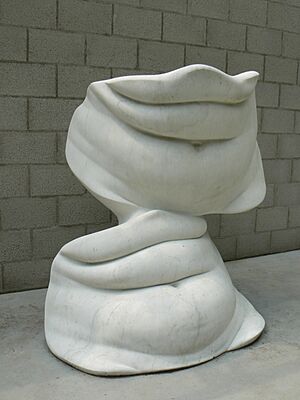Alina Szapocznikow facts for kids
Quick facts for kids
Alina Szapocznikow
|
|
|---|---|
 |
|
| Born | May 16, 1926 |
| Died | March 2, 1973 (aged 46) Praz-Coutant, Passy, France
|
| Resting place | Montmartre Cemetery, Paris |
| Nationality | Polish |
| Education | Ecole nationale Supérieure des Beaux-Arts, Paris |
| Known for | Sculpture, drawing |
| Spouse(s) | Ryszard Stanisławski, Roman Cieślewicz |
Alina Szapocznikow (May 16, 1926 – March 2, 1973) was a famous Polish sculptor. She was also a Holocaust survivor. Her art often featured casts of her own body or her son's body. She mostly used materials like bronze and stone. Her unique art style reminded people of movements like surrealism, new realism, and pop art.
During World War II, Alina was held in several places. These included the Pabianice and Łódź Ghettos. She was also in Auschwitz, Bergen-Belsen, and Theresienstadt camps.
Contents
Who Was Alina Szapocznikow?
Alina's Early Life (1926–1938)
Alina Szapocznikow was born in Kalisz, Poland, in 1926. She came from a Jewish family. Her father, Jakub, was a dentist. Her mother, Ryfka "Regina" Auerbach, was a pediatrician (a doctor for children). Alina and her younger brother lived in Pabianice, near Łódź.
She went to a small Polish elementary school in Pabianice. She also attended a State High School. Sadly, her father died in 1938 from tuberculosis, just before the war began.
Life During World War II (1939–1945)
When World War II started, Alina was only thirteen. Her brother went missing soon after. Alina and her mother were moved to the ghetto in Pabianice. They worked at the hospital there for two years. Her mother was a doctor, and Alina was a nurse.
They were then moved to the Łódź Ghetto. Later, they were sent to other camps. These included Auschwitz and Bergen-Belsen. Alina and her mother stayed in Bergen-Belsen for about 10 months. They were later moved to Terezin. They stayed there for another year before being separated. Alina's experiences at the very end of the war are not fully known. After the war, Alina went to Prague. Her mother returned to Łódź.
Alina rarely talked about her war experiences. However, in letters to her first husband, she mentioned the tough times. She wrote about the "despair" and how things ended "irretrievably several times" for her in the ghettos and camps. She felt ashamed to "brag" about her suffering.
Alina's Later Life and Art (1945–1973)
After the war, Alina Szapocznikow decided to study sculpture in Prague. She trained in different art studios. In 1947, she went to the Academy of Art and Industry in Prague. Later, she studied in Paris at the École nationale supérieure des Beaux-Arts.
In Paris, she met her first husband, Ryszard Stanisławski. He was an art historian. Being in France helped Alina grow as an artist. She learned the basics of sculpture. She was inspired by famous artists like Jean Arp and Henry Moore.
In 1951, Alina became very ill. She recovered after trying a new medicine. She then returned to Poland. In 1952, she married Ryszard Stanisławski. They adopted a son named Piotr. Alina took part in many art competitions. She created public sculptures for heroes and victims of the war. Alina and Ryszard divorced in 1958 but remained good friends. Later, she married Polish graphic designer Roman Cieślewicz in 1967.
In 1962, Alina had her own show at the Venice Biennale, a big art event. The next year, she moved to Paris. There, she became friends with art critic Pierre Restany. Alina's early sculptures were mostly in bronze and stone. They showed her own body and feelings.
Around 1963, she started using new materials. These included polyester and polyurethane. She combined them with parts of the human body. This new way of sculpting allowed Alina to show her personal feelings. These feelings came from her experiences with death and her memories of the war. She also showed how her own body was changing due to illness.
Alina's Final Years and Legacy
In 1968, Alina was diagnosed with breast cancer. After this, much of her art explored themes of illness and death. She created "tumor" sculptures using resin, gauze, and crumpled newspapers. She also used photos. Through these works, she wanted to show how the body changes and how it can be a source of pain.
Alina used photos of herself and her friends in her resin sculptures. This showed how sculpture and photography can capture sad or thoughtful moments. One of her last projects was a big idea for the Vesuvius volcano. She imagined a skating rink inside the volcano's crater. It would have lights, ski-lifts, and artificial snow. It was a playful but deep idea about challenging nature.
Alina Szapocznikow died on March 2, 1973. She passed away in Praz-Coutant, France, due to her illness.
What Are Alina Szapocznikow's Famous Works?
Sculptures of the Human Body
Alina Szapocznikow is known for her sculptures of the human body, often in pieces. Her work Difficult Age (1956) is made of plaster. This delicate material shows how fragile youth and beauty can be.
After her cancer diagnosis, Alina started her Tumors Personified series. She experimented with new materials like polyester resin and polyurethane. Most artists at the time were not using these materials.
One of her most famous works is Grands Ventres (Big Bellies). It shows two large bellies stacked on top of each other. Each is about five feet tall. Compared to some of her other works, these are very realistic and calm. Many of her other pieces were seen as bold or unusual.
The Bird Sculpture
In 1959, Alina Szapocznikow created the sculpture Bird in her studio in Warsaw. Bird was part of a series of abstract works. These works had a unique balance and looked like natural shapes.
Bird is made from cement and metal. It is very heavy for its size, standing 166 cm (about 5.4 feet) tall. The bird's neck and beak point upwards. Its wings are close together. This shows the tension of a bird about to fly, not fully on the ground but not yet in the sky.
There are several photos of Alina with Bird, including one by the famous photographer Tadeusz Rolke.
The sculpture was thought to be lost for over 50 years. It was last shown in 1961 in Washington, D.C. Then, it was found in a collector's outhouse in upstate New York! When Bird was sold in 2016, it set a record. It became the most expensive Polish sculpture ever sold. This work was shown to the public again at The Hepworth Wakefield art gallery.
Exhibitions (Solo and Two-Person)
- 1960 – 2nd Exhibition of the Sculptures of Alina Szapocznikow at BWA Arsenał, Poznań, Poland
- 1960 – Alina Szapocznikow (Drawings) at Farsettiarte, Prato, Italy
- 1960 – Alina Szapocznikow Confrontations at Galeria Krzywe Koło, Warsaw, Poland
- 1960 – Sculptures of Alina Szapocznikow at 13th Festival of Fine Arts, BWA Gallery, Sopot, Poland
- 1961 – Alina Szapocznikow (along with Roman Cieślewicz) at Gallery of Fine Arts, Rijeka, Yugoslavia
- 1961 – Alina Szapocznikow at Kordegarda Gallery, Warsaw, Poland
- 1962 – Alina Szapocznikow at 31st Biennale, Venice, Italy
- 1967 – Alina Szapocznikow at Florence Houston Brown Gallery, Paris, France
- 1967 – Sculptures of Alina Szapocznikow at Zachęta National Gallery of Art, Warsaw, Poland
- 1968 – Alina Szapocznikow at Cogeime Gallery, Brussels, Belgium
- 1969 – Outdoor show at Port-Barcarès, France
- 1970 – Envahissement de Tumeurs (Invasion of Tumors) at Stedelijk Museum, Amsterdam, Netherlands
- 1971 – Instant et Chose at Aurora Gallery, Geneva, Switzerland
- 1973 – Alina Szapocznikow – Tumeurs, Herbier at City of Paris' Museum of Modern Art, Paris, France
- 1974 – Alina Szapocznikow (Drawings) at Museum of Modern Art, Warsaw, Poland
- 1975 – Alina Szpocznikow (Drawings) at Aurora Gallery, Geneva, Switzerland
- 1975 – Retrospective Exhibition of Alina Szapocznikow: 1926–1973 at Museum Sztuki, Łódź, Poland
- 1976 – Untitled show at Municipal Gallery Arsenal, Poznań, Poland
- 1976 – Untitled show at Pałac Sztuki i Galeria Pryzmat (Palace of Art), Kraków, Poland
- 1976 – Untitled show at Municipal Art Gallery of Bydgoszcz, Bydgoszcz, Poland
- 1976 – Untitled show at National Museum, Gdańsk, Poland
- 1977 – Untitled show at Municipal Art Gallery of Białystok, Białystok, Poland
- 1978 – Untitled show at Regional Museum of the Kalisz, Kalisz, Poland
- 1978 – Alina Szapocznikow PhotoSculptures at Salon Krytyków, BWA, Lublin, Poland
- 1989 – Alina Szapocznikow: 1926–1973 at Galeria Sztuki Sceny Plastycznej KUL, Lublin, Poland
- 1990 – Alina Szapocznikow: 1926–1973 at Polish Library, Paris, France
- 1998 – Alina Szapocznikow: 1926–1973 at Zachęta National Gallery of Art, Warsaw, Poland
- 1998 – Alina Szapocznikow: 1926–1973 at National Museum, Kraków, Poland
- 1999 – Alina Szapocznikow: 1926–1973 at Museum Sztuki, Łódź, Poland
- 1999 – Alina Szapocznikow: 1926–1973 at National Museum, Wrocław, Poland
- 2000 – Alina Szapocznikow at Czech Museum of Art, Prague, Czech Republic
- 2010 – Out of My Mouth: Chewing Gum Sculptures The Photosculptures of Alina Szapocznikow at the Henry Moore Institute, Leeds
- 2012 – Alina Szapocznikow: Sculpture, Undone, 1955–1972, at The Museum of Modern Art, New York and at The Hammer Museum, Los Angeles
- 2013 – Alina Szapocznikow: Du dessin à la sculpture, at Musée National d'Art Moderne, Centre Pompidou, Paris
- 2015 – Them at Schinkel Pavillon, Berlin, Germany
- 2015 – Alina Szapocznikow at Andrea Rosen Gallery, New York
- 2017 – Alina Szapocznikow: Human Landscapes, at The Hepworth Wakefield, England
See Also
- List of Polish sculptors
Images for kids






